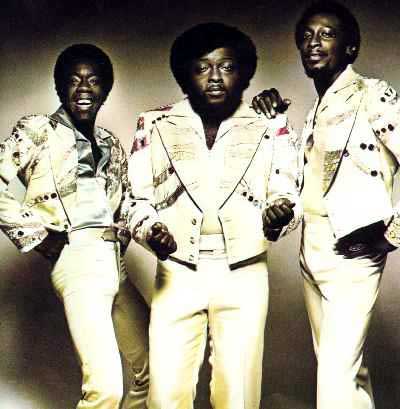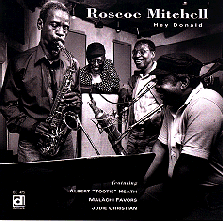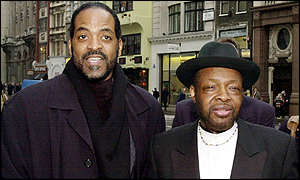
"The
legend of The Pharaohs starts at Crane Junior (Malcolm X) College on the West
side of Chicago. Under the tutelage of James Mack a student band is formed- The
Jazzmen, which in 1962 wins the best band category at Chicago's annual Harvest
Moon Festival. The band featured a front-line of Charles Handy (trumpet) Louis
Satterfield (trombone) and Don Myrick (alto sax) backed by Maurice White (trap
drums), RAMANANA (Fred Humphrey) (Piano) and bassist Ernest McCarthy. At the
time Chicago based Chess Records was fast becoming America's premier forum for
progressive Black music and Jazzmen: White, Satterfield and Handy became
prominent session players at the label joining an illustrious group which
already featured guitarist Pete Cosey, arranger /pianists Phil Wright and the
late great Charles Stepney.
At the time Chicago based Chess Records was fast becoming America’s premier forum for progressive Black music and Jazzmen White, Satterfield and Handy became prominent session players at the label joining an illustrious group which already featured guitarist Pete Cosey, arranger /pianists Phil Wright and the late great Charles Stepney.
The song was released in
October 1965. It hit the R&B charts and stayed in the top 40 for 19 months
and went gold in two months. "Rescue Me" was not only popular but had
a style all of its own with some talented people behind it who helped make it a
success:
"The song featured a crack horn section led by soul tenor Gene Barge. It
boasted heated call-and-response vocals, with Minnie Riperton among background
singers. And it was driven by a crack rhythm section including drummer Maurice
White (pre-Earth, Wind and Fire) and bassist Louis Satterfield (April 3, 1938),
whose monster riffs are frequently credited with the song's success."
It was during this formative period in life that the evolution of Earth, Wind and Fire began to develop. In 1965, while at Chess Records, Charles Handy assembled a group of his buddies to record his tune Hot Tacos. The and consisted of Charles Handy, Louis Satterfield, Pete Cosey, tenor player Oscar Rivers, drummer Morris Jennings, and Master percussionist Henry Gibson. The group eventually merged with the Artistic Heritage Ensemble to form The Pharaohs. At various points between 1965-1973, horn players Louis Satterfield (trombone), Don Myrick (saxes), Rahm Lee (trumpet) performed with the Pharaohs. They would soon form the nucleus of the Earth, Wind and Fire horn section.
"After
a while these musicians moved over to the South Side to the fledgling Afro Arts
Theater where they joined the Artistic Heritage Ensemble, under the leadership
of Phil Cohran. As the name suggests The Afro Arts Theater was more than just a
music venue, offering free concerts and tuition in music, yoga, dance and art
with an afrocentric perspective to the local community. Presently Cohran left to
teach at Malcolm X Junior College and Chuck Handy and The Pharoahs and the
Artistic Heritage Ensemble merged to form The Pharaohs; "that's how,"
narrates Handy "the group grew in size from a six piece group to an
orchestra".
"It was this version of the band: Satterfield (1962-1970), Handy, ‘Big' Willie Woods (Trombone), Oye Bisi (African drums), Shango Njoko Adefumi (African Drums), Black Herman Waterford (Quinto drum, alto sax), Don Myrick (saxes), Yehudah Ben Israel (guitar, vocals), Alious Watkins (trap drums, tuba), Derf Reklaw Raheem (percussion, flute), Aaron Dodd (Tuba); that in 197I recorded ‘The Awakening'. By 1972 when ‘In The Basement' was recorded the unit had expanded to include Derrick Morris (trap drums), Warren Bingham (guitar), Rahm Lee (trumpet) and Sue Conway (Vocal). For too few years the Pharaohs ruled but by 1973 it was all over.
"What
happened to the Pharaohs? In the early seventies Maurice White who had found
considerable success with Ramsey Lewis' third important trio, gathered together
many of his Chicago chums (including Handy, Myrick and Satterfield) to record a
demo, on the strength of which he inked a deal with Warner Bros. and returned to
Chicago to assemble a band. In the process he changed name, basing the new one
on the astrological signs of the three founding members: Earth Wind and Fire.

For
his early recordings (such as the soundtracks to Melvin Van Pebbles ‘Sweet
Sweetback's Badass Song' and the first Earth, Wind & Fire album ‘The Need
of Love') White approached Pharaohs Myrick, Satterfield and Yahudah (Yakov) Ben
Israel. After
scoring a major hit with the live recording of ‘Reasons' Myrick and
Satterfield joined Rahm Lee and Michael Harris to form The Phenix Horns, Earth
Wind and Fire's permanent horn section.
Earth,
Wind & Fire, followed the trail of gold West trod by so many mid Western
musicians and by Motown itself, moved out to Los Angeles while Charles Handy
preferred to remain in Chicago, continuing his studies in Egyptology at the
Field Museum of Natural History. The Pharaohs as a band were effectively gone
but their influence was undiminished: Earth Wind and Fire's Egyptian iconography
(from the Sphinx/Pyramid laden album art to the musical references to Sun
Goddesses and Serpentine Fires) owes as much to The Pharaoh's philosophy as
their horny percussive bass heavy groove does to The Pharaohs musical innovation
(it was Louis Satterfield who taught Verdine White to play bass, and Maurice the
Kalimba!). Earth Wind and Fire in turn have profoundly influenced popular music.
Maurice
loaned Earth Wind & Fire's signature Phenix Horns - Don Myrick on saxophone,
Louis Satterfield on trombone, Rahmlee Davis and Michael Harris on trumpets - to
his other production projects, the Emotions, Ramsey Lewis and Deniece Williams.
Then, on a tour of Europe, somebody else took interest in the famed horn
section. "We used to tour so much," said Maurice, "we used to
tour Europe. Phil Collins had an opportunity to see us. He would recruit our
horn section whenever we weren't using it."
Sure
enough, Collins imported the Phenix Horns into Genesis tracks like "No
Reply At All" and "Paperlate," and on his solo hits like "I
Missed Again," "Sussudio" and "I Cannot Believe It's
True." "I sometimes had to call and make an appointment to see my own
horn section," said Maurice. "They even toured with Genesis and Phil
Collins for a while."
On
July 30, in the summer of 1993, former 53 year old Phenix Horns member Don
Myrick, whose saxophone could be heard not only on Earth Wind & Fire's
albums, but also on albums from Bobby “Blue” Bland, The Dells, Regina Belle,
the Mighty Clouds of Joy, Heaven 17 and Phil Collins (it's Myrick's emotional
sax on Collins' hit "One More Night"), was shot to death in Los
Angeles, under circumstances that still remain a mystery to this day. Donald
Myrick was shot by the LAPD when his home was raided by mistake. It seems that a
police officer mistook a lighter Donald was holding for a gun.
"Don
hadn't worked with us in almost ten years," said Philip Bailey, "and
so we were on to other things, we had a new Earth Wind & Fire horn section.
I was in Los Angeles, and somebody called me and told me what happened. We were all very shocked and hurt that that had
happened. He hadn't worked with the band in quite some time. He did a solo for
me on one of my projects, and wasn't really feeling up to doing what I was used
to hearing him do. But later I learned that he was back and playing really well
and everything, so it was a real shock to us. He had been real sick one time and
close to death, we were thinking he was bouncing back. It’s still shocking
today.”
Donald
is laid to rest at the Inglewood Cemetery across the street from the Great
Western Forum, home of the Los Angeles Lakers.
Inglewood Park Cemetery
Inglewood
Los Angeles County
California, USA
On
August 4, 1995, Lawsuit
settled in Donald Myrick’s death according to the Associated
Press & the Union-Tribune.
In Santa Monica, the family of a rock musician Donald
Myrick, who was shot to death during a 1993 police raid, settled a
wrongful-death lawsuit against the city for $400,000, an attorney said
yesterday. The settlement came Monday on the eve of trial, ending
litigation
brought by Myrick's mother, wife and three daughters.
Myrick, a saxophonist who performed on
the Phil Collins hit "One More Night" and performed with such acts as
Earth, Wind and Fire, was killed July 30, 1993, while police were serving a
search warrant. Police said Officer Gary Barbaro fired one shot after
mistaking a butane lighter in Myrick's hand for a weapon.
Henry
Threadgill, composer, ensemble leader, reeds player, interviewed July 24, 1996
by Ted Panken, host of jazz and new music programs on the Columbia
University/New York City radio station WKCR.FM.
I
was leading up to ask you to tell us about the music program at Englewood High
School. It was like all the high school programs, pretty much. It was a band
program, and sometimes there would be small group rehearsals to work on Dance
Band music or Jazz Band music. We called it Stage Band, besides being in the
concert band... In other words, the concert band, the marching band, and then
the stage band where we would play big band arrangements. There were a lot of
great players at that school when I got there. Roscoe Mitchell, a great
saxophone player Donald Myrick, Steve McCall had gone there, Oscar Brown, Jr.,
Satterfield, the trombone player. There were a lot of good players there. Who
were some of the people who connected you into extending your research into
music? Was Roscoe Mitchell one? No, I met Roscoe very late. The first saxophone
player around that I really was influenced by that always was there with
encouragement was Donald Myrick. Donald was older than I was, and he was a very
fine saxophone player, very gifted when he was very young. There were band and
solo city competitions, and he had won several of these for a couple of years. I
was kind of following behind him to go to these contests, and play in the
different groups. He would take me around to different sessions on Monday nights
and Wednesday nights around the city.

It's
hard to believe that 30 years have passed since Delmark issued "Sound"
in 1966, the first recording of 26-year-old Roscoe Mitchell. This CD you hold in
your hand, "Hey Donald" was not intended as a commemorative release,
but a more exciting merging of musicians could not have been pulled off even if
that had been the plan.
This
CD is dedicated to Donald Myrick, the late saxophonist and one of Mitchell's
fellow founding members of the Association for the Advancement of Creative
Musicians who, among many other things, was an original member of Earth, Wind
and Fire.
Song
List:
1.
Walking In the Moonlight
2.
Dragons
3.
Jeremy
4.
The El
5.
Hey Donald
6.
Keep on Keeping On
7.
The Band Room
8.
Englewood High School
9.
Zero
10.
Song for Rwanda
11.
58th Street
12.
See You At The Fair
**************************************************************

Mr Justice Jonathan Parker ruled that Collins had overpaid Louis Satterfield 63, and Rahmlee Davies 51, a total of £244,000 in royalties.
But he made it clear the duo, once part of the group Earth, Wind and Fire, will not have to repay any of the money, and halved the amount the Oscar-winning musician had demanded from them.
The judge said it was "highly regrettable" the matter could not have been resolved before it went to court, and criticized Collins' company for its handling of the affair.
**************************************************************